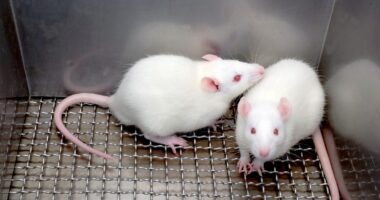Plant proteins offer therapeutic avenues for Huntington’s: Study
Lab-made enzyme prevented clumping in human cell, worm models

A lab-made version of a plant enzyme prevented toxic huntingtin protein clumps — that drive Huntington’s disease from forming — in human cell and worm models of the neurodegenerative condition, a study shows.
Called stromal processing peptidase (SPP), the enzyme is naturally present in plants’ chloroplasts, where sunlight is converted into energy, and is part of the organelle’s import/degradation machinery.
“Unlike humans, plants have chloroplasts, an extra cellular type of organelle that could provide an expanded molecular machinery to get rid of toxic protein aggregates,” Ernesto Llamas, PhD, the study’s first author and a postdoctoral researcher at the University of Cologne, in Germany, said in an university press release.
When chloroplast dysfunction was promoted, huntingtin aggregates accumulated in plants, confirming the organelle’s role in preventing these disease-causing protein clumps from forming. By leveraging these or other plant-based mechanisms, new therapeutic strategies for Huntington’s will emerge, researchers believe.
“Over the past years, we have seen several promising approaches to treating hereditary diseases like Huntington’s fail,” said Seda Koyuncu, PhD, one of the study’s authors and a postdoctoral researcher at the University of Cologne. “We are confident that our plant synthetic approach will lead to significant advances in the field.”
The study, “In-planta expression of human polyQ-expanded huntingtin fragment reveals mechanisms to prevent disease-related protein aggregation,” was published in Nature Aging.
Role of huntingtin protein aggregation in Huntington’s
In Huntington’s disease, a trio of nucleotides (DNA’s building blocks) called CAG is repeated too many times in the HTT gene. This CAG trio provides instructions for producing an amino acid called glutamine. Amino acids are the building blocks of protein.
This results in the mutant huntingtin protein having too many glutamine molecules, making it prone to misfolding and forming toxic clumps in nerve cells, causing their degeneration.
The neurodegenerative disease is one of nine known conditions in humans called polyglutamine (polyQ) diseases that feature abnormally long glutamine expansions in certain proteins.
While plants have many proteins with polyQ repeats, they don’t seem to lead to aggregation and disease like they do in humans.
The multidisciplinary research team thought that by understanding how plants remain resilient against polyQ-associated disease, a unique treatment approach might be found.
“Many people don’t notice that plants can persist amongst variable and extreme environmental conditions that cause protein aggregation,” Llamas said. “I believe that plant molecular mechanisms hold the key to discovering new drugs that can prevent human diseases.”
Huntingtin aggregates in plant model
The researchers used genetic techniques to promote the production of aggregation-prone human huntingtin in Arabidopsis thaliana, also known as rock cress or thale cress, a widely used plant model.
The plants were able to prevent huntingtin protein aggregation and didn’t show any signs of toxicity, with normal development, growth, and lifespan.
“We were surprised to see plants completely healthy, even though they were genetically producing the toxic human protein,” said David Vilchez, PhD, the study’s senior author and a professor at the University of Cologne. “The [production] of mutant huntingtin in other models of research like [lab-grown human cells], mice and nematode worms induce detrimental effects and symptoms of disease.”
The mutant huntingtin interacted with several chloroplast proteins, suggesting these organelles may be able to import and break down the problematic protein before it can form clumps.
This is likely related to chloroplasts’ role in proteostasis, a process where cellular health is maintained by making sure properly folded proteins are produced at the right time and place, and misfolded ones are cleared away.
Consistent with this hypothesis, genetic or pharmacologic disruption of chloroplast proteostasis in the plants resulted in mutant huntingtin aggregates accumulating.
SPP protein interacts with huntingtin
SPP, a chloroplast protein involved in proteostasis and the import of proteins into chloroplasts, was found to strongly interact with mutant huntingtin.
“Our data suggest that aggregation-prone [mutant huntingtin] could be recognized by the chloroplast import machinery for further processing by SPP,” wrote the researchers, who evaluated whether promoting the production of a lab-made version of SPP in human cell and worm models of Huntington’s would have the same protective effect.
SPP production was found to significantly reduce the aggregation of toxic huntingtin clumps in both models and to prevent the worms’ loss of motility that’s thought to reflect neurodegeneration.
“Given the interaction of [mutant huntingtin] with SPP and the absence of aggregation in plants with functional chloroplasts, we hypothesized that plant-derived SPP could be a potential treatment for human polyQ-related neurodegenerative diseases,” wrote the researchers, who cautioned that more research was needed to “elucidate the detailed molecular mechanisms by which SPP prevents the aggregation of polyQ-expanded proteins, because SPP does not appear to promote degradation in human and worm models.”
SPP was also found to interact with a range of other proteins in human and worm cells, which could lead to off-target effects “and unintended consequences that require further investigation,” they wrote.
“In future work, we aim to express SPP in mouse models of Huntington’s disease to further explore therapeutic effects and possible off-target consequences,” Vilchez and Llamas wrote in an accompanying Research Briefing published in the same journal. “If the results in mouse models are promising, we will establish further collaborations to make progress toward clinical trials.”
The researchers believe research with plants could be applied to treating human disease and understanding aging. They have received funding to continue exploring this idea.
“Our plan is to found a startup to produce plant-derived therapeutic proteins and to test them as potential therapeutics to treat neurodegenerative diseases in humans,” Llamas said.







